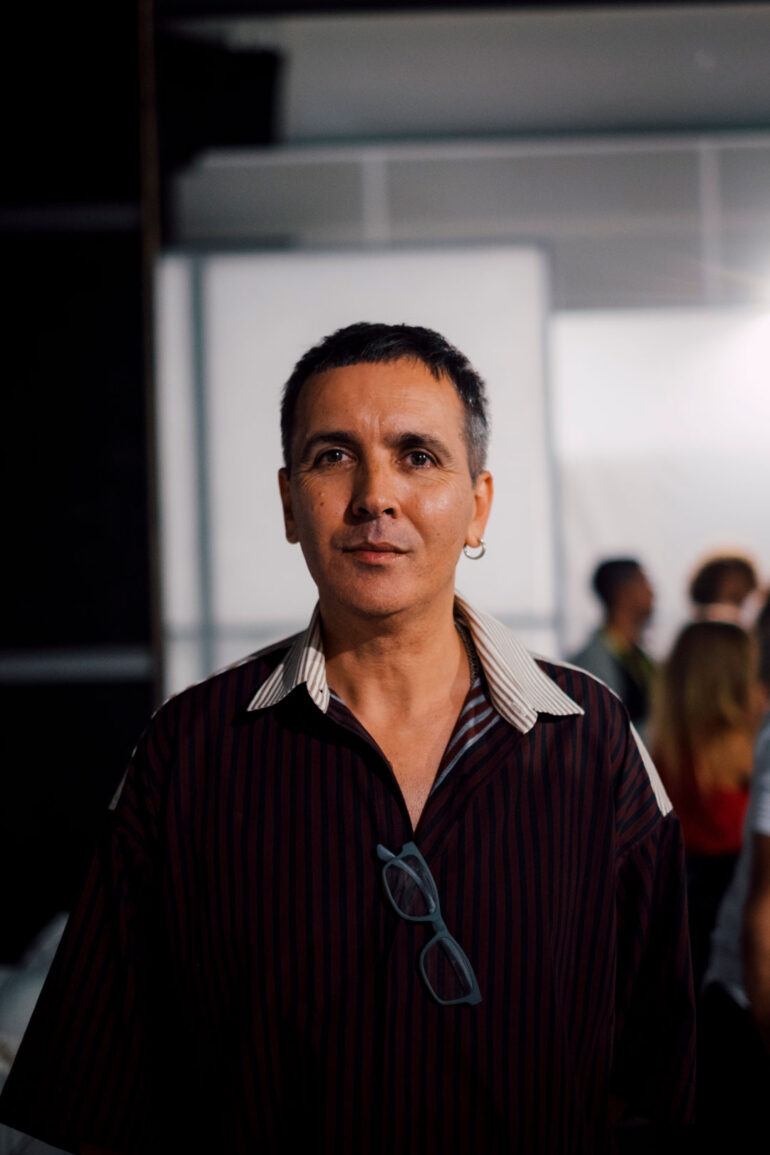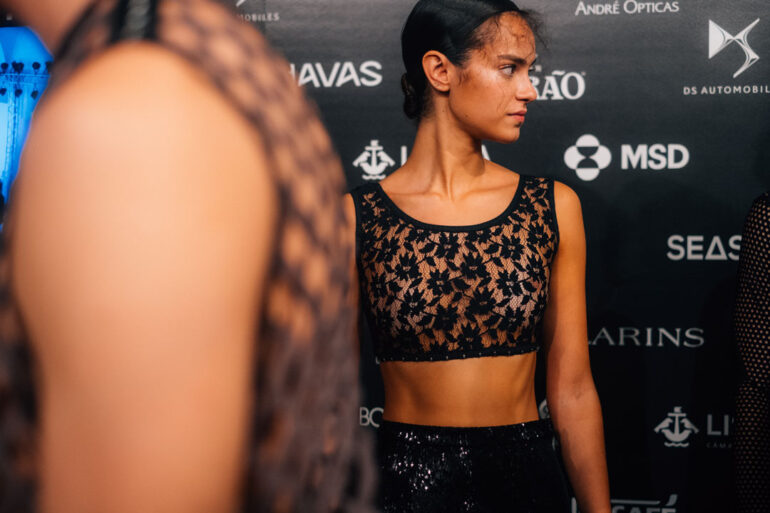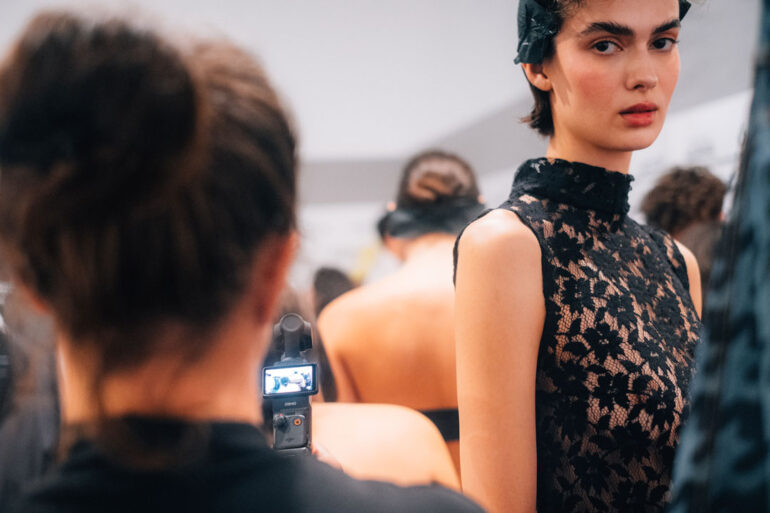One foot on the moon, the other on earth
Words and photos: Tomás Monteiro
It is late 2023, October to be more precise. We are watching the Portuguese Golden Globes, a ceremony where the best in arts is recognised. Later that evening, the award came up for the person who stood out the most in fashion. There were five nominees, and out of all, Dino Alves won the award. From all the people he thanked — an extensive list that included, we think, everyone he could thank — he left his parents to last, to whom he dedicated that award.
“To my parents, who always let me be who I wanted to be, and that’s why I’m standing here today”.
Dino Alves was born in Anadia, a town near Aveiro, to a household of a father, mother and an older sister. His memories go back to a childhood in which his attention was fully focused on anything arts-related. Back then, in the 1970s, people had a different sense of assimilation as there was less information circling than there is nowadays. For a small kid living in a small town without many external stimuli as today, there was something like a natural call for what would become his life.
Dino did not have any artists in his family. Still, he did have something for which every child would crave: the support of both his parents to express himself as he wanted to.
Back then he did not have many options for shopping clothes, so the ritual was to have a sewing machine at home and to hire a seamstress who would spend a week sewing clothes for the family members. Each time this happened, he would get two or three pieces of clothing made from the fabrics and designs he would choose. Even though he was around six years old, he was already drawn to German art magazines and movies he had watched, and his mind was fixated on ideas brought by them. As time passed, he also became the one responsible for choosing his sister’s clothes.
His mother, who died when he was only nine years old, was a crucial pillar to Dino, as a child, to embrace his creativity. He recalls her being a sensitive woman, especially during a time in which people were reluctant to go a bit out of the norm. His father was a much more reserved man who, even though he did not express much, a product of the times, as he tells me. As we speak about his childhood, Dino says that he credits his father’s ways to the typical upbringing of the time, to a matter of natural insensitivity.
However, they both went on an endless journey to go after a specific outfit that Dino wanted to buy but needed to know where it was sold. He did not even know if he had seen it somewhere or dreamt about it. So, they checked all the stores in Anadia, Coimbra, Aveiro, even Oporto — that was further away —, and finally, when they went a second time to Aveiro, they found the trousers. Looking back, Dino finds this specific want quite odd, especially for a seven-year-old boy without formal art education.
His teenage years led him to Porto, where he studied Painting. Between his senior year and enrolling in college, Dino stayed in Anadia and worked at his cousin’s boutique. She was full of life and ideas, so the shop was completely different from everything else there was at the time. Dino started working there doing many things, the most important being the shop window’s design. Even when he went to study in Porto, he continued to contribute by shopping at the boutique.
Once he graduated with his bachelor’s degree, he went to the capital, Lisbon, where he wanted to start working as a painter and stage designer, as for he also wanted to work in plays. Meanwhile, he got an office job at Cinemateca (the oldest institution of cinema publishing in Portugal) to pay his bills and stayed there for seven years. Going from one function to another, he credits much of his visual culture to the archives he had access to and what he watched during those years working there.
However, even though he was completely unaware of the possibility of pursuing a career in fashion, all it took him to realise what was about to become his job was a friend.
As of today, he is clear about fashion: it is a way of living, from the core, the way you feel and your personality to how you express yourself. It determines how you experience the world and your surroundings, and how you incorporate that in your most truthful self, clothes included. Even though he now looks back and sees fashion as an inevitable destiny of his life, there were no fashion courses or an industry at that time. So it was unclear to Dino that it could mean a valid career for him.
When he came to Lisbon, he witnessed the nightlife on which artists from multiple crafts would thrive and enjoy themselves in a safe space; especially in Lux, Frágil and Bairro Alto. From being the one person wearing his own pieces, he met other artists and actors, and all it took was a small step from that to do it for other people. He would spend his whole week creating something to wear during the weekend. All his impulses were to create something to tell a particular story through his clothes. Gradually, he began to create pieces for his friends and then for actors who needed to be styled for major events.
During this time, 30 years ago, Dino Alves created his first collection for ‘Manobras de Maio’, an event based in Lisbon that featured multiple designers. With no formal education in fashion whatsoever, it was through his genuine experiments that people recognised in him a quality that would add something different to the other designers selected. That friend of his, an actor he worked for before, told him to apply. After a lot of thinking and reluctance to do such a thing, he decided to deliver a project plan that — of course — he customised. That small object became the golden pass for Dino to enter the roster that would later present their collections. After this decision, it was all made clear to him that he had to do this; to create and to express his thoughts and stories through fashion pieces.
After a couple of years creating what he would present in Manobras de Maio, he got a surprise phone call from Ana Salazar — said to be the mother of fashion design in Portugal — asking him to do the creative direction of her show in ModaLisboa. From then, he was just one season away from being invited to be a part of the ModaLisboa roster.
Throughout the following years, Dino embraced an unexpected turn of events in his life. He became a storyteller who combined ideas, stories and statements with the craft of cloth-making. His first show back in 1994 had five pieces made from scratch; the rest was what we all now call upcycling. From his collections of clubs’ uniforms, restaurants, hotels and hair salons, to costumes for television, stage and cinema, he has done it all. Since 2022, he has been the designer of the uniforms of Marcha da Bica, which won the main prize in the 2023 Marchas Populares, and he has developed many concepts for artists, actors and musicians.
When it comes to his work, he firmly states that he always, always wants to go all the way. Dino recalls many times he had ideas that sounded impossible — especially for his own shows — but they all exceeded expectations in the end. ‘What’s the most important thing for me in a work of art is honesty’, he said when I asked what is the one thing a piece of work has to showcase for him to be moved and to have something to say about it. That is also what he finds to be the core of every piece and body of work he does. The key is always to be aware of one’s surroundings and to have a genuine interest in everything, even if in the end you find it rubbish. For all these years, Dino has been collecting references that he turns into art and statements, always driven to exceed the status quo.
At the beginning of every collection he has an idea, most of the time, for the whole show. He then creates five key pieces that lead to variations to support the narrative he wants to create. Due to all these projects he accepted to fulfil his creative needs, there were times when he had to finish his collection on the day of the show. But, in the end, it all goes well; it all happens under this feeling of adrenaline that leads to something special and worth remembering. While designing them, Dino’s mind begins the process of finding the narrative between (styling) and the rest, as they say, is history and can be witnessed either live or later via the show’s recording.
Dino Alves is one of those people who put so much passion into his work that no one can keep themselves from feeling inspired by it. When asked about why he still keeps pushing the boundaries that other people impose to his work he said: ‘This is my life. We never know how many years of life we have left, but this is what I will leave behind. If I give up on an idea of mine that wants to give up on life altogether. When it comes to my own creations, being stubborn, as people often call me, has paid off for all these past years.





